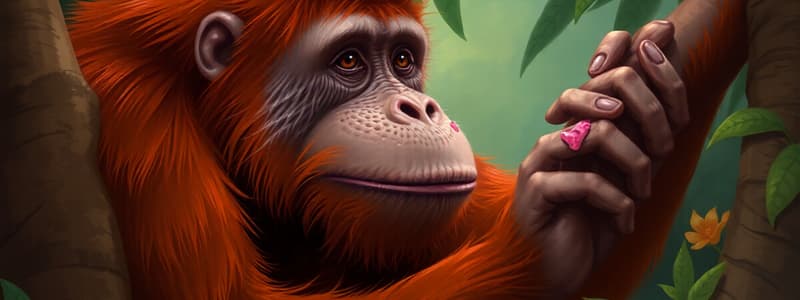Podcast
Questions and Answers
What was the initial behavior observed in Rakus after he sustained his cheek wound?
What was the initial behavior observed in Rakus after he sustained his cheek wound?
- He struggled to eat regular food.
- He interacted aggressively with other orangutans.
- He began chewing on a medicinal plant. (correct)
- He rested extensively in a tree.
How did Rakus protect his wound from flies after treating it?
How did Rakus protect his wound from flies after treating it?
- He applied more plant juice.
- He avoided moving his arm.
- He covered it with leaves. (correct)
- He covered it with mud.
What crucial factor contributes to the vulnerability of Sumatran orangutan populations?
What crucial factor contributes to the vulnerability of Sumatran orangutan populations?
- Their slow reproductive rate. (correct)
- Their wide geographic distribution.
- The legality of hunting.
- Their high birth rate.
Which medicinal plant did Rakus utilize for treating his wound?
Which medicinal plant did Rakus utilize for treating his wound?
What was the duration from the initial observation of Rakus' wound to complete healing?
What was the duration from the initial observation of Rakus' wound to complete healing?
When did the researchers publish their findings about Rakus in a journal?
When did the researchers publish their findings about Rakus in a journal?
What is the primary cause of the decline in Sumatran orangutan populations?
What is the primary cause of the decline in Sumatran orangutan populations?
What is significant about Rakus' behavior in the context of animal behavior studies?
What is significant about Rakus' behavior in the context of animal behavior studies?
Flashcards
Rakus's Self-Medication
Rakus's Self-Medication
A Sumatran orangutan named Rakus demonstrated self-medication by using a medicinal plant called liana to treat a wound on his cheek, showcasing an understanding of its healing properties.
Orangutan Wound Cause
Orangutan Wound Cause
Rakus's wound was likely caused by a fight with another orangutan, suggesting that conflicts are a part of their social interactions.
Liana's Medicinal Properties
Liana's Medicinal Properties
Liana, the plant Rakus used, is traditionally known for its healing properties by local communities.
Rakus's Wound Treatment
Rakus's Wound Treatment
Signup and view all the flashcards
Rakus's Wound Healing Time
Rakus's Wound Healing Time
Signup and view all the flashcards
Rakus's Aftercare
Rakus's Aftercare
Signup and view all the flashcards
Sumatran Orangutan Threats
Sumatran Orangutan Threats
Signup and view all the flashcards
Sumatran Orangutan Habitat
Sumatran Orangutan Habitat
Signup and view all the flashcards
Study Notes
Orangutan Wound Treatment
- Rakus, a 35-year-old Sumatran orangutan, treated a cheek wound with a medicinal plant.
- The wound, likely caused by a fight, was observed by Dr. Laumer's team on June 22, 2022.
- Rakus chewed on a liana plant, known for its healing properties by locals.
- This behavior was unusual for Sumatran orangutans.
- Rakus spent 13 minutes eating the plant and 7 minutes chewing leaves and applying sap to the wound.
- When flies appeared, he used leaves to cover the wound.
- The wound healed completely within five days, leaving only a scar by July 19, 2022.
- This is the first known documented case of active wound treatment in a wild animal using a medicinal plant.
Sumatran Orangutan Conservation Status
- Sumatran orangutans are critically endangered, with only about 14,600 remaining in the wild.
- They are located in the northern parts of Sumatra, Indonesia.
- Their numbers are declining due to rainforest conversion for oil palm plantations and agriculture.
- Illegal hunting for food and status symbols also poses a danger.
- Low birth rates (one infant every 8-9 years) make the species vulnerable.
Studying That Suits You
Use AI to generate personalized quizzes and flashcards to suit your learning preferences.





